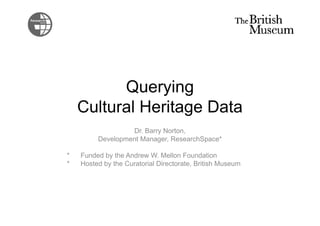Mon norton tut_querying cultural heritage data
- 1. Querying Cultural Heritage Data Dr. Barry Norton, Development Manager, ResearchSpace* * Funded by the Andrew W. Mellon Foundation * Hosted by the Curatorial Directorate, British Museum
- 2. Statements and Patterns ŌĆó For one edge in a graph: crm:P52_has_current_owner bm-obj:EOC3130 bm-id:the-british-museum
- 3. Statements and Patterns ŌĆó For one edge in a graph: crm:P52_has_current_owner bm-obj:EOC3130 bm-id:the-british-museum ŌĆó We can declare/retrieve one (N)Triple:
- 4. Statements and Patterns ŌĆó For one edge in a graph: crm:P52_has_current_owner bm-obj:EOC3130 bm-id:the-british-museum ŌĆó We can declare/retrieve one (N)Triple: ŌĆó Or write this in Turtle: @prefix crm: <http://erlangen-crm.org/current/> . @prefix bm-obj: <http://collection.britishmuseum.org/id/object/> . @prefix bm-id: <http://collection.britishmuseum.org/id/> . bm-obj:EOC3130 crm:P52_has_current_owner bm-id:the-british-museum .
- 5. Statements and Patterns ŌĆó For one edge in a graph: crm:P52_has_current_owner bm-obj:EOC3130 bm-id:the-british-museum ŌĆó We can write this in Turtle: ŌĆó And check for it in SPARQL: bm-obj:EOC3130 crm:P52_has_current_owner bm-id:the-british-museum . PREFIX crm: <http://erlangen-crm.org/current/> PREFIX bm-obj: <http://collection.britishmuseum.org/id/object/> PREFIX bm-id: <http://collection.britishmuseum.org/id/> ASK {bm-obj:EOC3130 crm:P52_has_current_owner bm-id:the-british-museum} true
- 6. Statements and Patterns ŌĆó For a set of edges: bm-obj:EOC3130 bm-id:the-british-museum ? crm:P51_has_former_or_current_owner ? ŌĆó We can do the work on the client: ŌĆó Or have the server do it by turning the triple into a triple pattern: bm-obj:EOC3130 crm:P51_has_former_or_current_owner ?owner
- 7. Exercise ? Questions: ŌĆó Why is the answer different? ŌĆó Who are the two (other) one-time owners? ?
- 8. Solutions & Exercises ŌĆó Why is the answer different? ŌĆō Reasoning, part of the work by the server (being a triplestore) means that if two things are related by crm:P52_has_current_owner then theyŌĆÖŌĆÖre related by crm:P51_has_former_or_current_owner ŌĆó This is part of the work that the server (triplestore) can do for you ŌĆó Exercise: query for the (strictly) former ownersŌĆ” ? ?
- 9. Solution 1/2 ŌĆó Using specific server functionality:
- 10. Solution 2/2 ŌĆó In pure SPARQL:
- 11. Solutions & Exercises Who are the two (other) one-time owners? ŌĆó Since people and institutions (and places) are ? ? treated as are concepts, the names of the former owners are attached using skos:prefLabel ŌĆó Exercise: if you didnŌĆÖt already, include the names in your query results
- 12. Solutions & Exercises If you didnŌĆÖt already, include the names in your query results: Question: Why are we back at two answers?
- 13. Answer ŌĆó Answer: ŌĆō Just as we can add triples together to make a graph in RDF, so we can add triple patterns together in SPARQL to make a graph pattern ŌĆō By default all triple patterns must be matched, but we can use the OPTIONAL {} pattern to allow variation ŌĆó Exercise: ŌĆō Query for the owners and their names, if they exist* * N.B. this bug in the BM data will be fixed soon
- 14. Solution
- 15. Exercise ŌĆó Take a look here: ŌĆó Exercise: copy and run this query
- 16. CSV Exercise ŌĆó Type: ŌĆó Observe that one can now paste the query including line breaks* ŌĆó Type: * N.B. for now you should first replace the "s with 's and change the one occurrence of ecrm: with crm: - weŌĆÖll fix this * N.B. currently the query needs to be simplified as the BBC data is not loaded ŌĆō this will be available soon
- 17. Data Analysis ŌĆó One can import this CSV file into many tools: ŌĆō A spreadsheet can be a good way to carry out basic visualisations ŌĆō A scripting environment like (i)python/scipy or R can allow more analysis before visualisation, but: ŌĆó both languages also have libraries to encapsulate interaction via SPARQL (rdflib/sparqlwrapper and SPARQL/RCurl respectively) ŌĆó one should decide whether more analysis should first be carried out using SPARQLŌĆ”
- 18. Exercise ŌĆó If you havenŌĆÖt so far, click on one of the (HotW) 100 Objects (such as number 70, Hoa Hakananai'a Easter Island Statue) having run the main query ŌĆó Choose a material and observe the query for other objects in this material ŌĆó Adapt this query to count how many BM objects are made from basalt
- 19. Solution & Exercise ŌĆó Exercise: Now count the ŌĆśtop tenŌĆÖ materials and the number of objects for each
- 20. Solution
- 21. A Last Word ŌĆó SPARQLing a ŌĆśnative RDFŌĆÖ database (often called a ŌĆśtriplestoreŌĆÖ) is not the only option before defaulting to programming ŌĆó A ŌĆśnative graphŌĆÖ database indexes the graph in a different way, supporting traversal-oriented queries






















